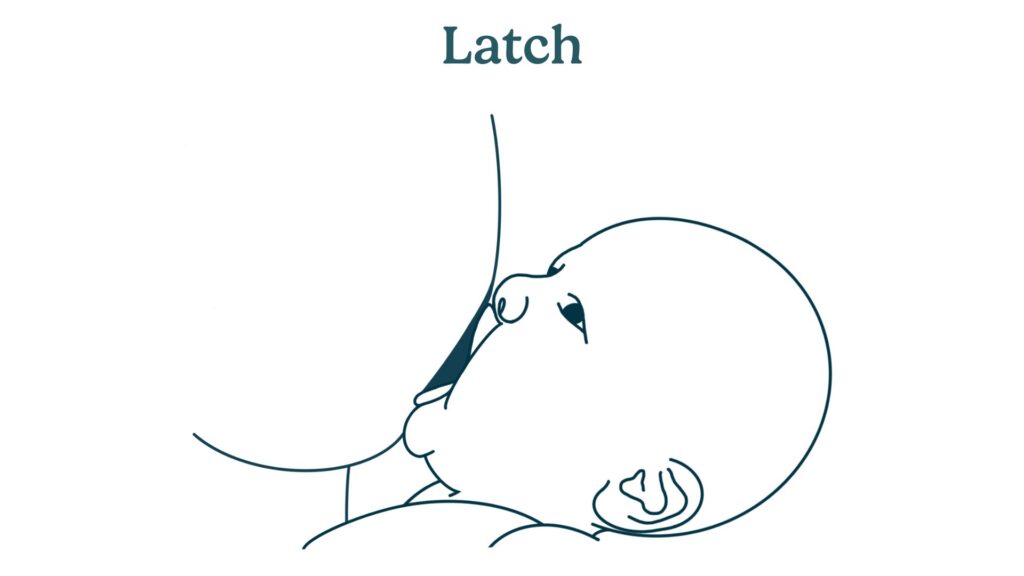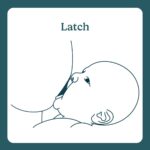latch

Latch
Latch refers to how your baby attaches to your breast during breastfeeding. A good latch is important for effective milk transfer, preventing nipple pain, and ensuring that your baby gets enough milk.
What to watch out for
It’s important to recognize the signs of a good latch and understand how to achieve it. Here are some considerations and tips:
Signs of a Good Latch
- Comfortable feeding: You should feel a gentle pulling sensation but no pain during breastfeeding. Breastfeeding should not be painful.
- Nipple shape: Your nipple should look rounded, not flattened or creased, after feeding.
- Effective milk transfer: Watch your baby for wide and rhythmic jaw movements as your baby sucks and swallows regularly. Baby should seem satisfied after the feeding.
- Baby’s positioning: The latch should be asymmetrical, with more of the areola visible above baby’s top lip and less below the bottom lip.
- Output: Your baby should have an increasing number of wet and dirty diapers each day, especially in the early days. Typically, a newborn should have 1 wet and 1 dirty diaper on day one, 2 of each on day two, and so on. By day five, expect 5-6 wet diapers and at least 2-4 bowel movements daily. If your baby is producing fewer diapers than expected, consult your pediatrician.
- Adequate weight gain: Your baby should gain weight appropriately, indicating they are receiving enough milk.
Achieving a Good Latch
- Positioning: Make sure your baby is positioned correctly with their body facing you. Baby’s chest and hips should be in a line and pressed against your body. Common positions include the cradle hold, cross-cradle hold, football hold, and side-lying position. Learn more about breastfeeding positions.
- Wide-open mouth: Encourage your baby to open their mouth wide before latching. You can gently tickle their upper lip with your nipple to stimulate a wide gape.
- Chin-first approach: Aim to bring your baby to your breast chin-first, allowing them to take in a large portion of the areola, not just the nipple.
- Support: Support your breast with one hand as you bring baby to it. Once you bring baby close, guide your areola into baby’s mouth. Infants might need more help with this practice in their first days of life.
- Sandwich Hold: Use the “Sandwich Hold” by using your thumb and fingers to gently squeeze your areola parallel to baby’s mouth, making it easier for them to latch.
Tips for Managing Latch
- Re-latch: If you feel pain or see signs of a shallow latch, gently break the suction by inserting a clean finger into the corner of your baby’s mouth and try latching again.
- Stay relaxed: Ensure you and your baby are both comfortable and relaxed during breastfeeding. Stress and tension can affect latching.
- Consult a lactation consultant: If you continue to have trouble with latching, seek help from a lactation consultant for personalized support and guidance.
Blog post: How to Fix a Shallow Latch & Get Baby to Latch Deeper
Physical limitations or health circumstances
Certain conditions can influence the ability to achieve a good latch:
- Tongue tie: A condition where the tissue under the tongue is too tight, restricting movement and making it difficult for the baby to achieve a deep latch.
- Lip tie: A condition where the tissue connecting the upper lip to the gum is too tight, affecting the latch.
- Premature birth: Premature babies may have weaker sucking reflexes and may need extra support to achieve a good latch.
- Engorgement: Swelling and discomfort of the breasts due to milk accumulation, which can make latching more difficult. Hand-express to relieve engorgement.
Other terms
Understanding related terms can help you better manage latching issues and related breastfeeding practices:
- Areola: The darker area surrounding the nipple. A deep latch includes a good portion of the areola in the baby’s mouth.
- Nipple shield: A tool that can help protect sore nipples and improve latch in some cases. Learn more about nipple shields.
- Let-down reflex: The release of milk from the breast triggered by your baby’s sucking. Learn about let-down.
- Cluster feeding: Periods when a baby feeds more frequently over a few hours, often in the evening.
- Lactation consultant: A professional who can provide support and guidance on breastfeeding issues, including latching problems.


